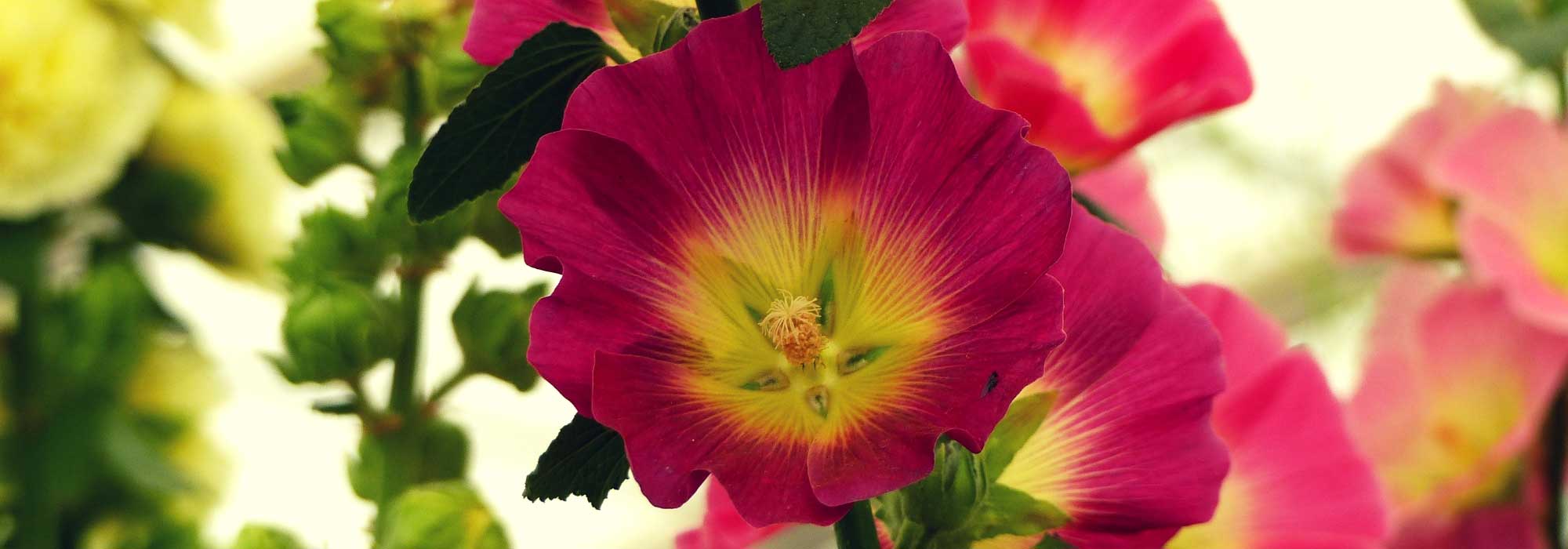
Hollyhock: sowing, planting, caring for
Contents
Hollyhock in a nutshell
- Hollyhock, with its tall, majestic silhouette, is one of the most architectural plants in a garden
- Its immense flower spikes, covered in flowers with single corollas or very double, pompon-like corollas, often exceed 2 m in height
- It blooms abundantly throughout summer in very soft, romantic colours or very deep shades, including black, a fairly rare colour
- This perennial, often grown as a biennial, prefers warm positions sheltered from strong winds
- An emblem of English gardens, it is a pretty, somewhat wild plant typical of cottage gardens
A word from our expert
Hollyhock or Alcea is a beautiful perennial plant often grown as a biennial, indispensable in country gardens and has become the symbol of Île de Ré where it thrives along walls, in the lanes of Saint Martin, well sheltered from the wind.
This tall, graceful plant lifts all summer from June to September its immense floral spikes, often exceeding 2 m in height, adorned with flowers in open cups or in very double, ruffled pompon forms showing colours from pastel to the darkest tones.
In the language of flowers, hollyhock signifies simple love!
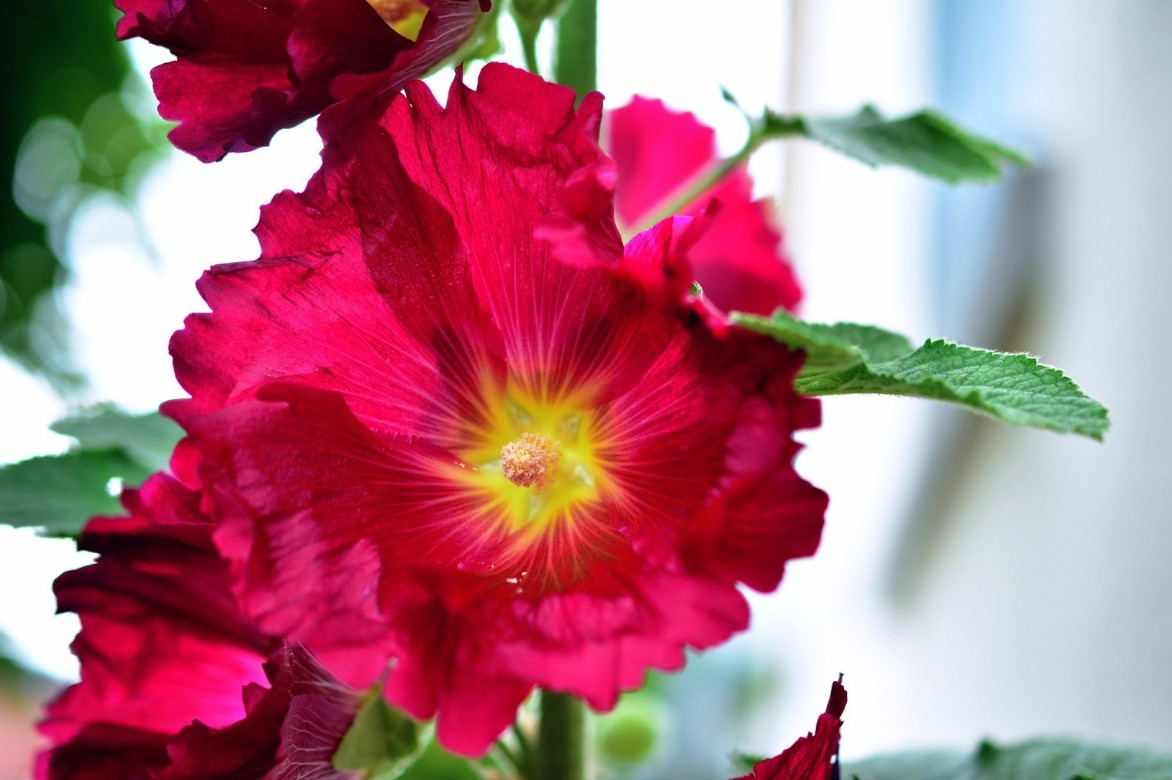
Double hollyhock or single-flowered, black, blackcurrant or powder-pink hollyhocks, all are ideal to bring verticality and a wildly romantic touch to the back of borders, or to the walls of a cottage walled garden against which they lean.
One of the easiest to grow, it adapts to ordinary soils, tolerates drought, likes warm, sheltered situations and self-seeds very easily in the most unexpected places.
Edible, hollyhock can be enjoyed in salads or in jams.
Discover all our varieties of hollyhocks in bucket or in seeds, how to collect and harvest hollyhock seeds and how to prune hollyhocks!
Description and botany
Botanical data
- Latin name Alcea
- Family Malvaceae
- Common name Hollyhock, Passerose, Stick-rose, Jacob's staff
- Flowering June to September
- Height 1 to 3 m
- Exposure Sun, partial shade
- Soil type All, well-drained
- Hardiness -15°C
La Hollyhock, Alcea rosea (formerly called Althaea), also sometimes known as Passerose, Stick-rose, Papal rose or primerose, is a short-lived perennial, annual or biennial plant of the family Malvaceae like mallows, lavateras, hibiscus, its close cousins.
Native to temperate regions of Europe and Asia where it grows in rocky places and dry wastelands. It has naturalized in abandoned gardens and fallow land.
The genus comprises about 60 species of hollyhocks of which the most widespread is Alcea rosea. It has given rise to numerous varieties and hybrid series with single or very double flowers (series ‘Chater’s’, ‘Halo’, ‘Simplex’, ‘Spotlight’) and interesting selections in varied colours, such as dwarf hollyhocks ‘Majorette Mixed’ or ‘Summer Carnival’, grown as annuals.
Althaea rugosa, with yellow flowers and leaves covered with hairs, and Alcea ficifolia or the fig-leaved hollyhock, are much less used in gardens. Hybridised with Alcea rosea, the latter appears in shades of pink, red or white, as in the ‘Antwerp Mixed’ selection.
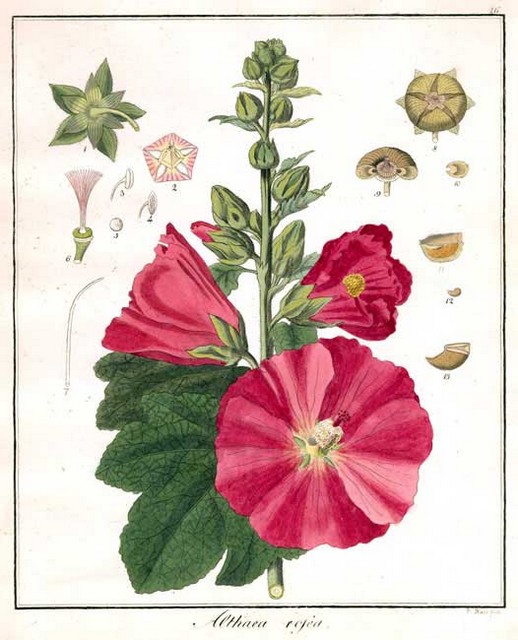
Alcea rosea – botanical illustration
On a taproot, it quickly develops a graceful, bushy clump with an upright habit. From each rosette of rounded leaves emerge sturdy, hairy stems that reach 1 to 2.5 m in height, often exceeding human height.
Leaves are deciduous or semi-evergreen, covered with rough hairs, mid- to pale green or green-grey, up to 18 cm long, rounded with undulate margins, cut into 3 or 7 shallow lobes, sometimes veined. In Alcea ficifolia, they recall fig leaf shape.
They are arranged alternately along unbranched stems.
Hollyhock is recognisable by its sturdy, majestic flowering spikes, always striking in a summer garden. From June to September, on these hairy stems appear countless flowers with a crumpled texture.
These spikes, very dense or more open, are topped by large buds that open progressively from base to tip, into delicate corollas, single, semi-double or fully double in cultivars, 2 to 10 cm in diameter.
Depending on variety, flowers open as wide 5-petalled crinkled cups like hibiscus flowers, or as large ruffled pompons evoking a peony.
Short-lived, these simple, silky flowers with translucent texture last only one day.
They display shades ranging from very soft and warm pastels to intense, even rare tones, from powder-pink, salmon-pink, to yellow, bright red, through garnet red, blackcurrant and the famous ‘black’ of Alcea rosea ‘Nigra’, which is actually very dark violet.
Hollyhocks of the ‘Halo’ series offer large flowers in bicoloured cups trimmed with a lighter halo around a contrasting centre.
Unscented, they are highly melliferous and attract many butterflies, foraging insects and pollinators.
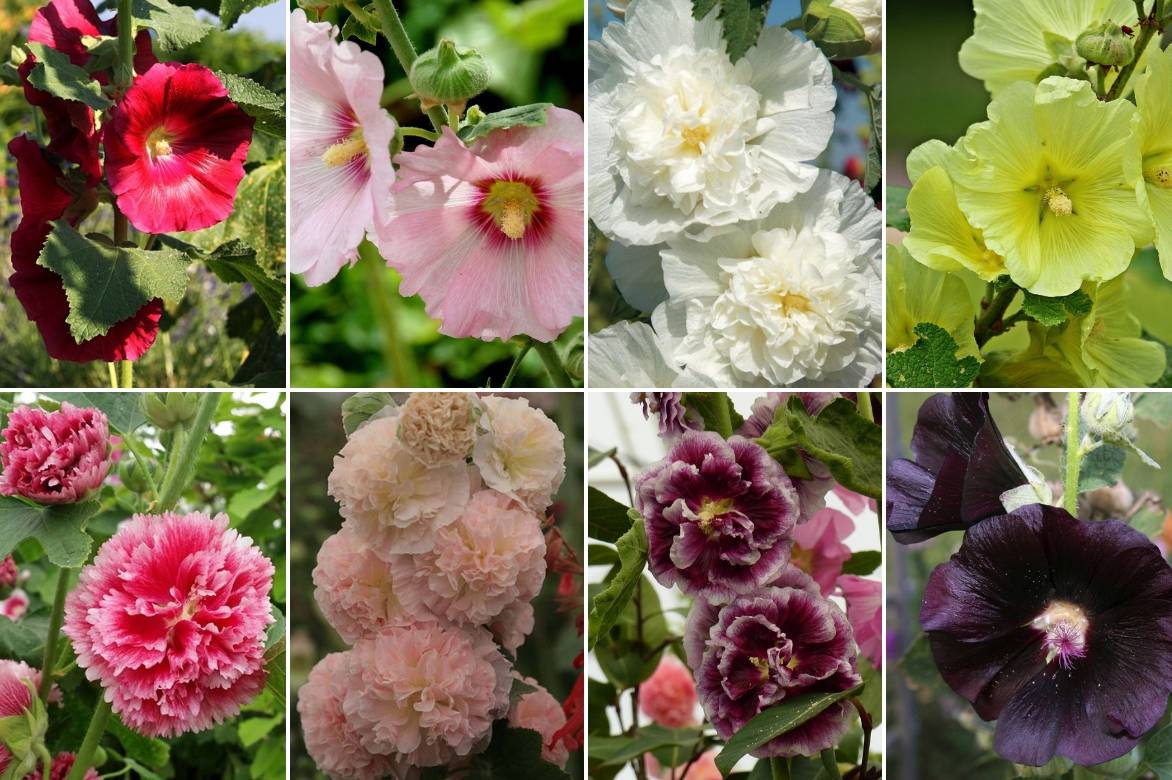
Hollyhocks offer a beautiful diversity of forms and colours
Flowering gives way to numerous capsule fruits filled with small brown, round, flat seeds that self-seed freely.
Hollyhock, hardy to -15°C, is often perennial in southern France where it tolerates drought well, and short-lived in cooler climates where it is commonly grown as a biennial. Easy to grow, while content with ordinary, even poor or stony soils, rather dry and well-drained, it flowers better in rich soil. It requires a sunny location sheltered from wind which can flatten the flowering spikes.
Typical of cottage gardens, hollyhock is often grown at the back of beds, in borders or leaning against a wall. The tall, architectural silhouettes are classics of English and natural-style gardens.
As attractive as it is tasty, hollyhock is an edible plant; its flower buds can be eaten raw in salads and its young leaves raw in salads or cooked as a purée.
An oil with soothing properties is extracted from its seeds.
Main species and varieties
Sixty species of hollyhocks are recognised, but the best known and grown in our gardens is Alcea rosea. It has given rise to many cultivars and series with single or very double flowers; the ‘Chater’s’, ‘Halo’, ‘Simplex’ and ‘Spotlight’ series. There are also interesting selections such as the dwarf hollyhocks ‘Majorette Mixed’ and those of ‘Summer Carnival’, grown as annuals.
Varieties with single flowers are more resistant and some new series of hybrids, selected by Thompson & Morgan, show greater resistance to rust, a disease well known in hollyhock.
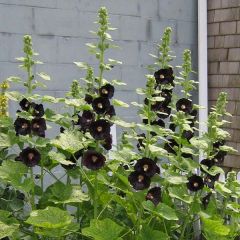
Alcea rosea Nigra - Hollyhock
- Flowering time August to October
- Height at maturity 2 m
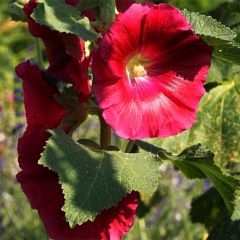
Alcea rosea Mars Magic - Hollyhock
- Flowering time August, September
- Height at maturity 1,80 m

Alcea rosea Halo Blossom - Hollyhock
- Flowering time August to October
- Height at maturity 1,50 m
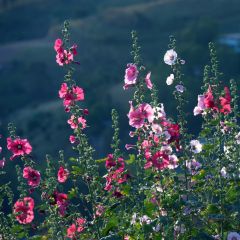
Alcea rosea 'Simplex'
- Flowering time July to November
- Height at maturity 1,80 m
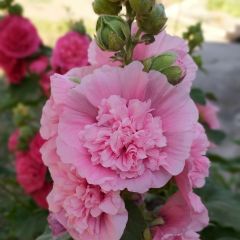
Alcea rosea Chaters Double Rose - Hollyhock
- Flowering time August to October
- Height at maturity 2,20 m
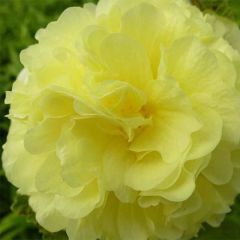
Alcea rosea Chaters Double Jaune - Hollyhock
- Flowering time August to October
- Height at maturity 2,20 m
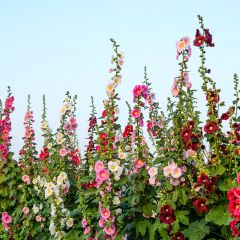
Alcea filicifolia Antwerp Stars Mix Seeds - Hollyhock
- Flowering time July to September
- Height at maturity 1,50 m
Discover other Alcea rosea - Hollyhocks
View all →Available in 2 sizes
Available in 2 sizes
Available in 0 sizes
Available in 1 sizes
Available in 1 sizes
Available in 1 sizes
Available in 2 sizes
Available in 1 sizes
Available in 1 sizes
Available in 1 sizes
Planting
Where to plant hollyhock?
Hardy down to -15°C, the hollyhock thrives almost everywhere in France, except perhaps in very windy areas. It is grown as a short-lived perennial (usually lives 3 or 4 years) in southern France where it tolerates drought well, and as an annual or a biennial in cooler climates.
Frequent spontaneous sowings allow renewal of young plants.
Although hollyhock adapts to many types of soil, it prefers rich, well-drained, calcareous soil.
It prefers to be placed on a sunny, sheltered, open site, which will encourage it to reach its full height. Once established, it does not like transplanting, so avoid disturbing it.
A too windy situation is a threat for this tall perennial. It requires staking to prevent stems breaking at the slightest gust or heavy rain, otherwise your border could look like a battlefield! Plant it along a wall or surround it with roses that will act as supporters.
With its tall silhouette, hollyhock is always highly structural in English or naturalistic gardens, where it asserts itself in country-style compositions to add movement and verticality.
Hollyhock fits into all natural settings, and can serve as a dazzling background plant for mixed borders, as flowers for beds, as avenue edging or to screen an unsightly wall.
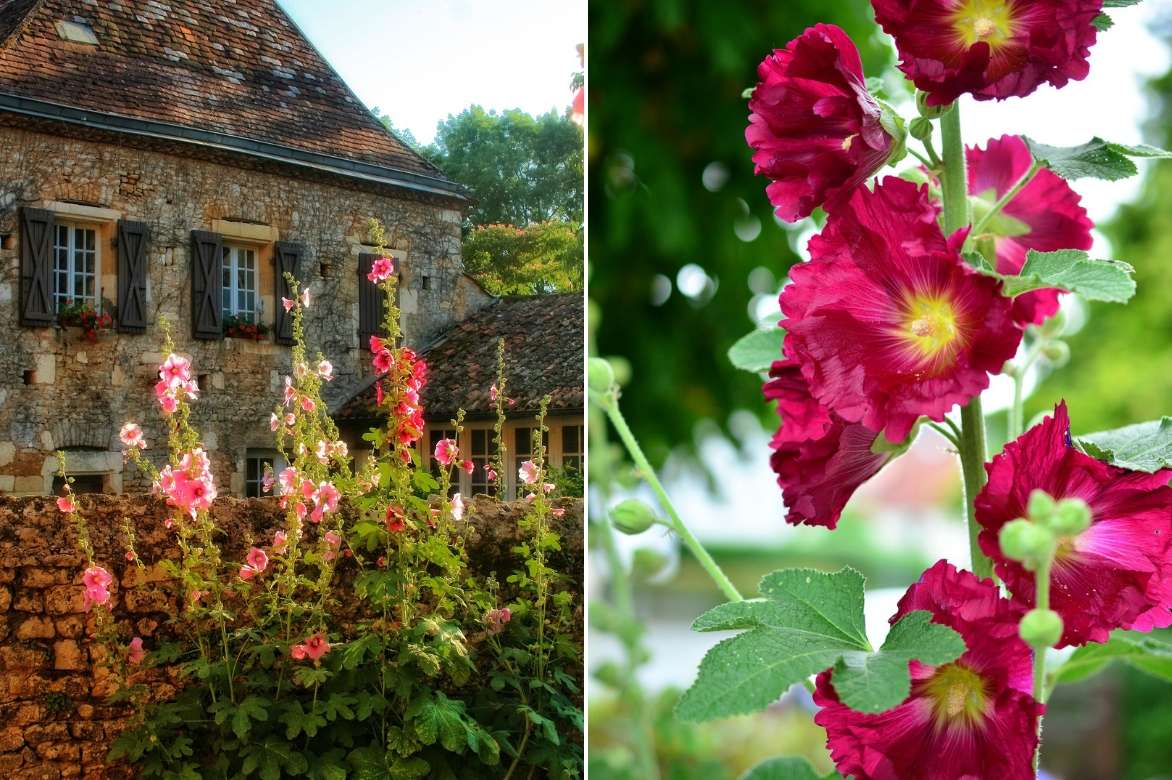
When to plant hollyhock?
The hollyhock is preferably planted in spring from March to May after last frosts, or possibly from September to October.
How to plant hollyhock?
In open ground
Allow 4 to 6 plants per m², spacing them 50 cm apart and planting them irregularly for a more natural result.
- Soak root ball in a bucket of water before planting
- Work the soil well
- Make a gravel bed at bottom of hole for good drainage
- Plant, mixing planting compost into garden soil
- Stake hollyhocks most exposed to wind
- Firm soil and water regularly until established
When and how to sow hollyhock (Alcea rosea) seed ?
How to collect hollyhock seeds?
After flowering, collect the small brown seeds gathered in concentric circles inside the dried capsules: only harvest fully dry fruit. The hollyhock seeds have high seed viability for at least 4 years after harvest. Store dry and protected from light.
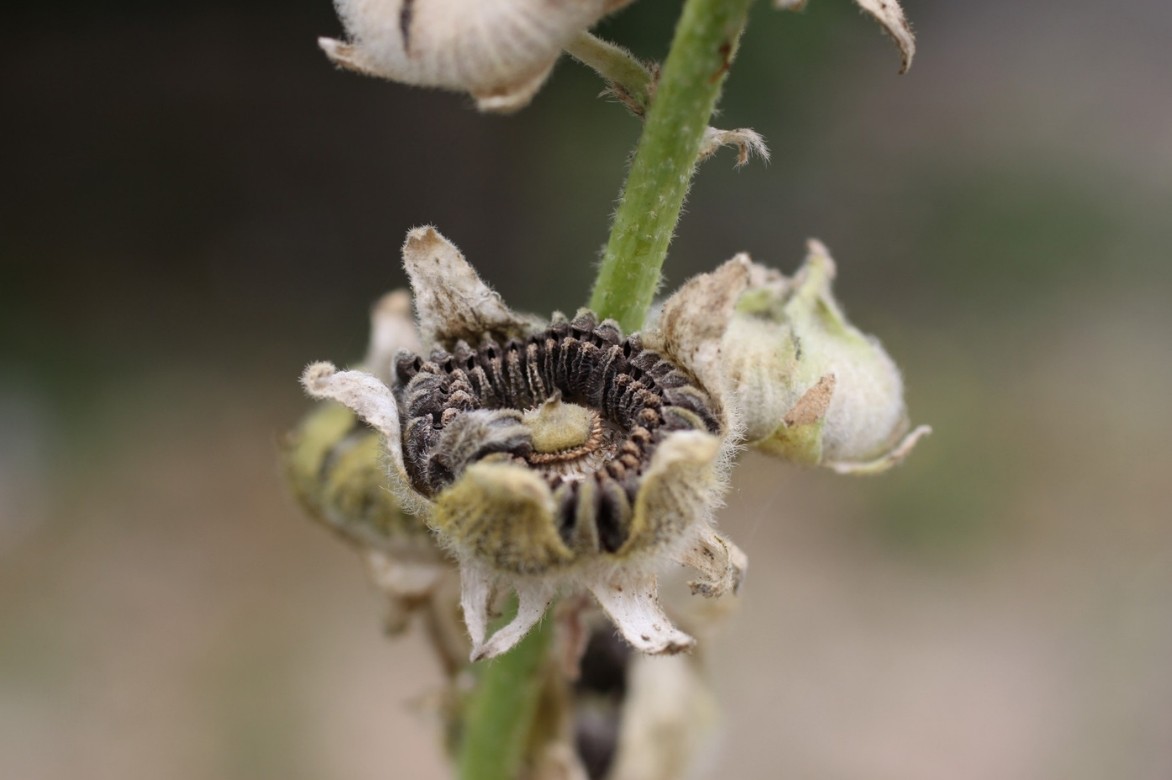
Hollyhock seed capsule (photo Jean-Pierre Bazard)
Direct sowing outdoors
Sowing is done in situ from March to May, depending on region, to obtain flowers the following year. Discover our advice to easily succeed with your hollyhock sowings.
- Crumb soil to depth of a spade
- Sow thinly by broadcasting in a sheltered spot in garden without sowing seeds too close together, or sow 2 to 3 seeds per pocket
- Cover with a few millimetres of seed compost
- Firm lightly with back of a rake
- Water with a fine spray and keep soil consistently moist
- Thin out to leave only one young plant every 30 cm in all directions
In seed trays
Hollyhock seeds are sown in summer from May to July for flowering the following year. You can also make earlier sowings in early spring for flowering during the next summer.
- Sow thinly by broadcasting in a seed tray or in buckets filled with seed compost mixed with a little sand
- Cover seeds with a little seed compost
- Firm lightly
- Keep moist under a frame sheltered from sun until germination, which occurs between 15 and 20 days
- Thin out some young plants at emergence
- Prick out young plants when they reach 7 cm high, that is when they have 3 or 4 leaves
- In autumn, plant them out in beds, spacing plants 30 cm in all directions or in troughs
Maintenance, pruning and care
Very easy to grow, hollyhock is undemanding and requires little maintenance.
Ideal for unattended gardens as it copes without watering once established: water regularly, especially during dry spells, but do not overwater and avoid wetting foliage.
Stake hollyhock in windy sites.
In autumn, apply a mulch to protect the stump from cold in regions with harsh winters.
Young plants of perennial hollyhocks lose vigour as they age and die out quickly, within three to four years. Do not hesitate to renew plants regularly.
How to prune hollyhocks?
In October, with a pruning shear, remove spent flower stems by cutting clumps back to soil level, or leave them to seed for self-sowing.
Possible diseases and pests
Hollyhock has a well-known enemy: rust, a leaf disease caused by a fungus visible as orange pustules left on the foliage. Harmless to the plant, it is mainly unsightly. Avoid its appearance by not watering the foliage, as moisture favours its development. As a preventive measure, in spring apply sprays of Bordeaux mixture combined with horsetail manure. If disease occurs: remove and burn infected plants. New series of hybrids (Thompson & Morgan) offer greater resistance to rust.
When first leaves appear, it is wise to protect them from feeding by slugs and snails. Apply slug treatment at planting and renew as necessary. Discover our 7 ways to fight slugs effectively and naturally and how to make a slug trap.
In dry weather, flea beetle, a small beetle, may appear, chewing leaves. To prevent this, mulch the base of hollyhocks, as this small insect dislikes moisture. You can also kill two birds with one stone by spreading wood ash around plants: its repellent effect will also deter slugs!
If hollyhocks are infested with aphids that make the leaves sticky and tacky: spray with water mixed with black soap.
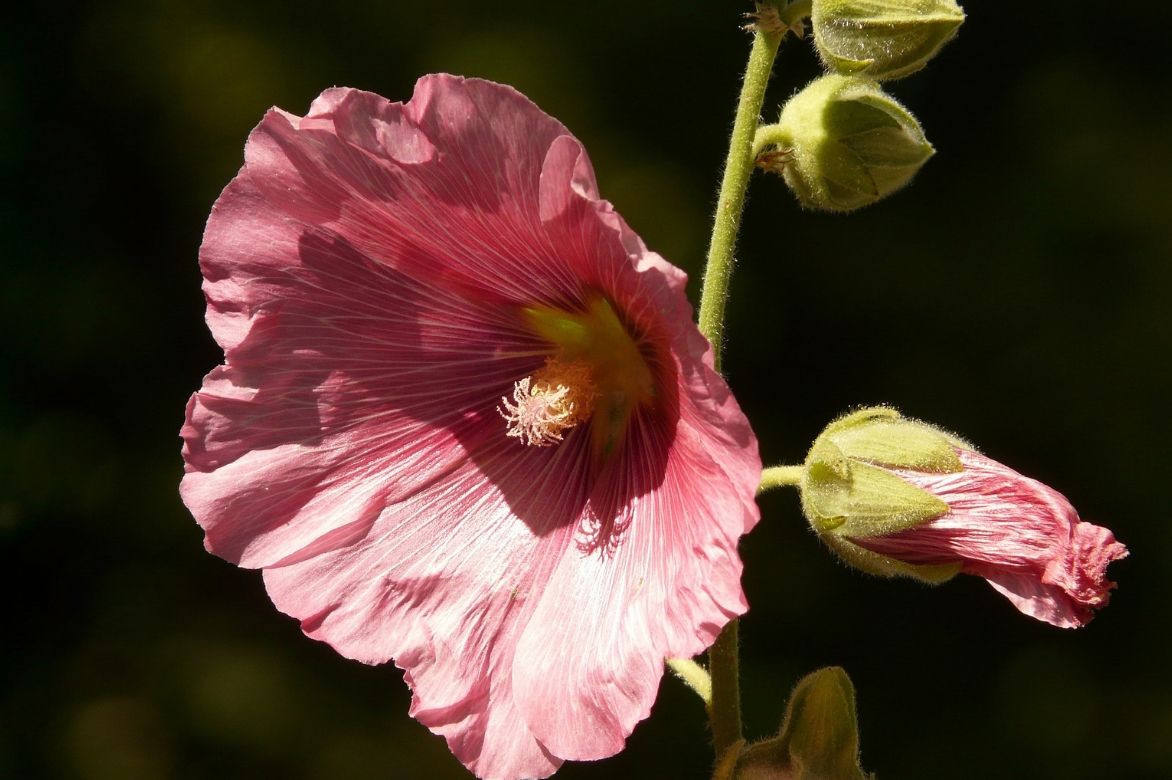
Multiplication
Hollyhock self-seeds spontaneously and often in unexpected places if not cut back immediately after flowering. Raising hollyhock by sowing remains simple, but resulting colour is unpredictable because sowing rarely produces plants true to parent plant.
Seeds are harvested at ripeness if you have not cut all flower stalks; otherwise discover our hollyhock seed packets. Annual species generally self-seed and do not tolerate transplanting well, which is why they are sown in place in spring.
Sow at 13°C in February under cover or directly in place in April for growing as annuals. It is also possible to sow hollyhock seeds in July; they will then flower the following year.
Companion plants for hollyhocks
With their tall, highly architectural silhouettes, the hollyhocks are reliable choices for herbaceous borders, informal gardens, country gardens, natural or gardener-free spaces. Their majestic clusters of pink, black or white flowers are classic features of country gardens and English cottage gardens.
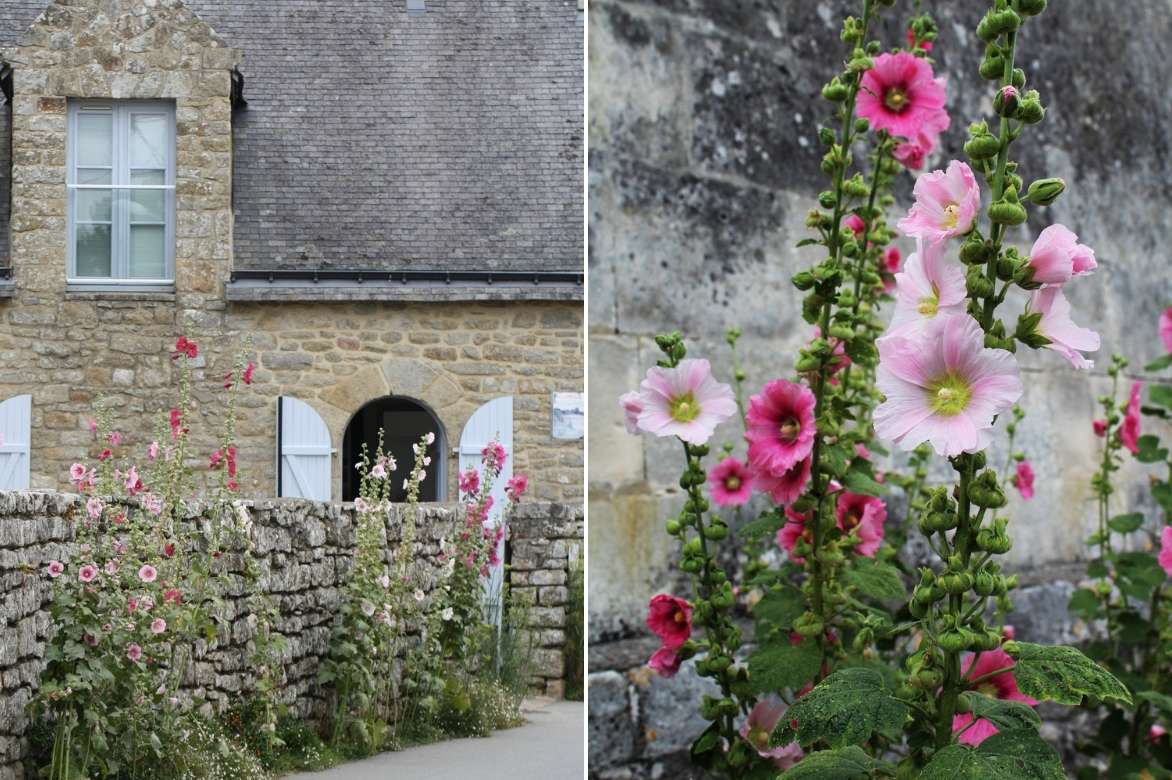
They are indispensable in pink or white gardens where they create delightfully romantic scenes. They are wonderful at the back of borders, or for covering walls of an enclosed garden.
Their pastel or stronger-coloured flowers allow superb pairings with dark or light forms. They will act as punctuation in a border of summer-flowering bushes such as hibiscus, buddleias, hydrangeas.
In shimmering, abundant mid-summer displays, varieties with soft shades will pair well with achilleas, monardas, ornamental alliums, nepetas, agastaches, nigellas, cosmos, two charming annuals.
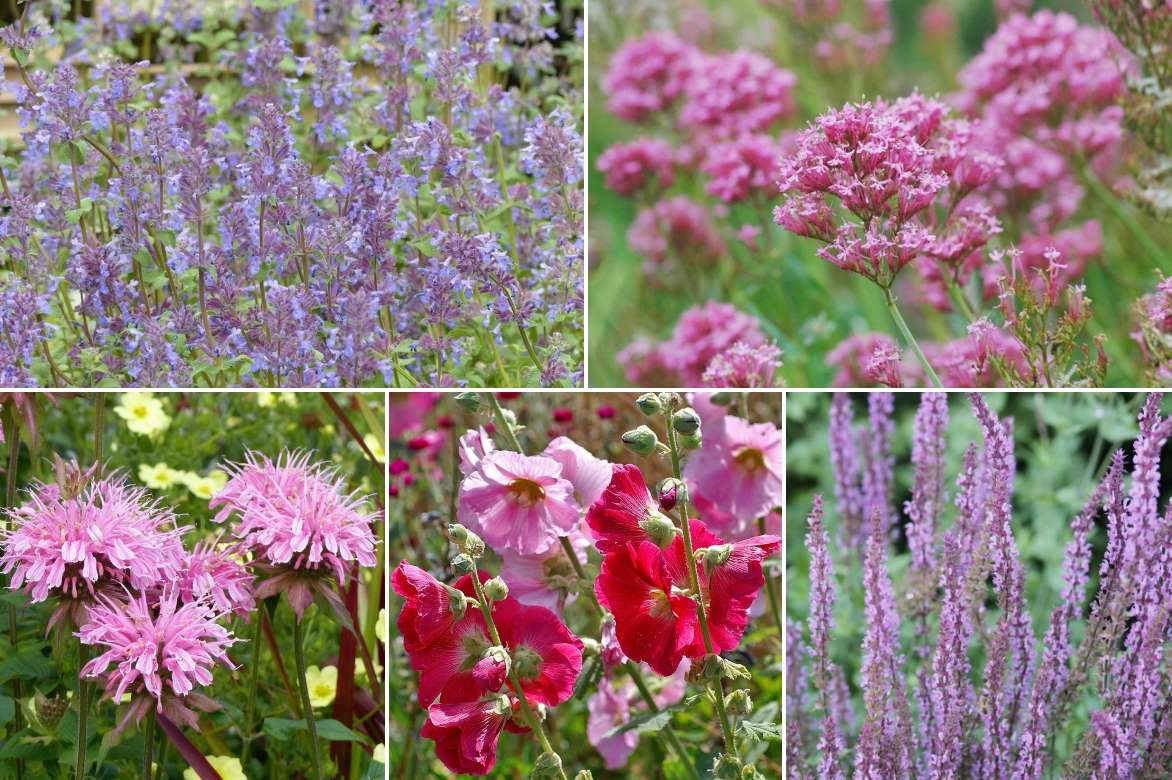
Example of a romantic pairing: Nepeta ‘Six Hills Giant’, Centranthus ruber ‘Kempenhof’ (photo CaptainMish), Monarda ‘Croftway Pink’ (variety close to ‘Beauty of Cobham’), Alcea Rosea (photo Jürgen Mangelsdorf – Flickr), Salvia nemorosa ‘Amethyst’
In more contrasting, colourful scenes, pair hollyhocks with valerian, oriental poppies, eryngium and delphiniums to create combinations as opulent as they are ephemeral.
Hollyhocks with intense, deep colours — garnet red, blackcurrant or black — will let you create superb ‘Red and Black’ inspired schemes.
They also combine very well with each other: mix single-flowered varieties with generous pompom double-flowered cultivars.
They are excellent companions for old roses for charming pairings.
→ Discover more pairing ideas with hollyhocks in our guide!
Useful resources
- Sow hollyhocks now! Don’t miss Michaël’s tips for successful sowing!
- Discover our tutorial: How to prepare a hollyhock infusion?
- How to harvest and store your hollyhock seeds? Our advice
- Discover our collections of annual young plants, available as seeds or as potted young plants
- Black flowers in the garden, discover Alcea rosea ‘Nigra’ and its dark companions, it’s fascinating!
- Subscribe!
- Contents
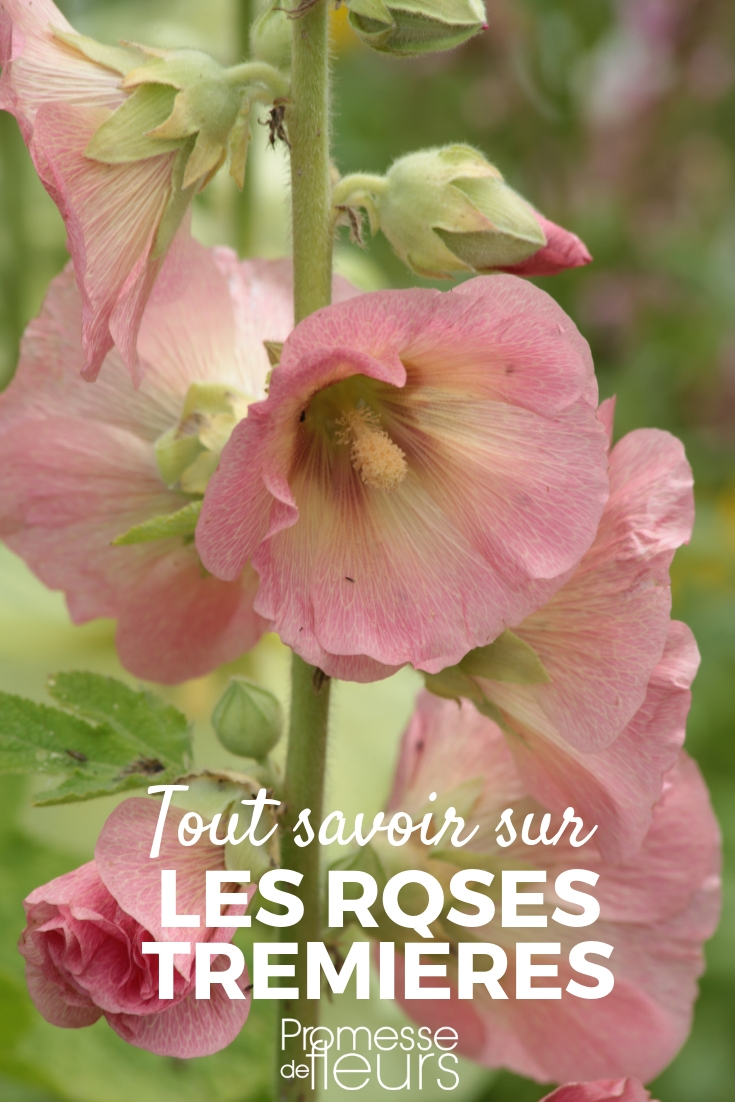



































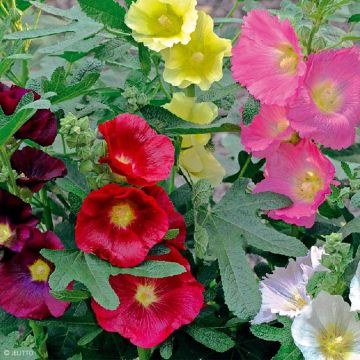
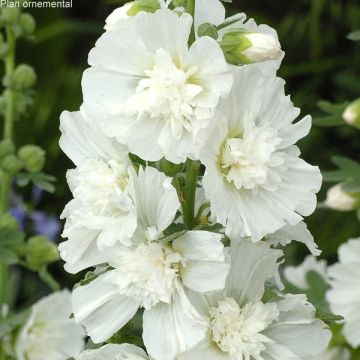
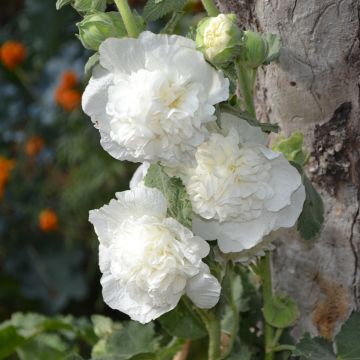
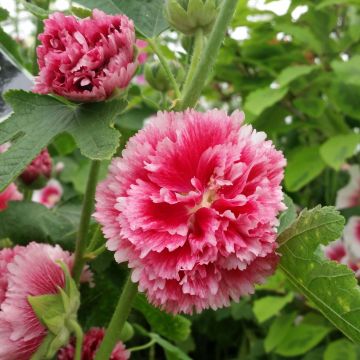
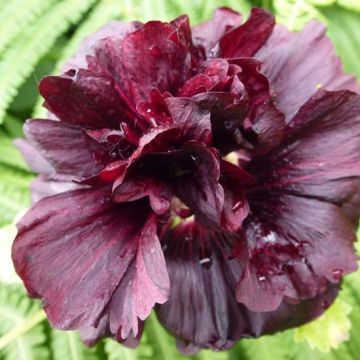
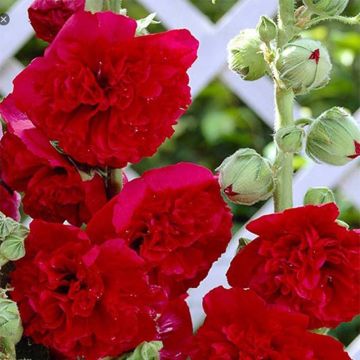
Comments